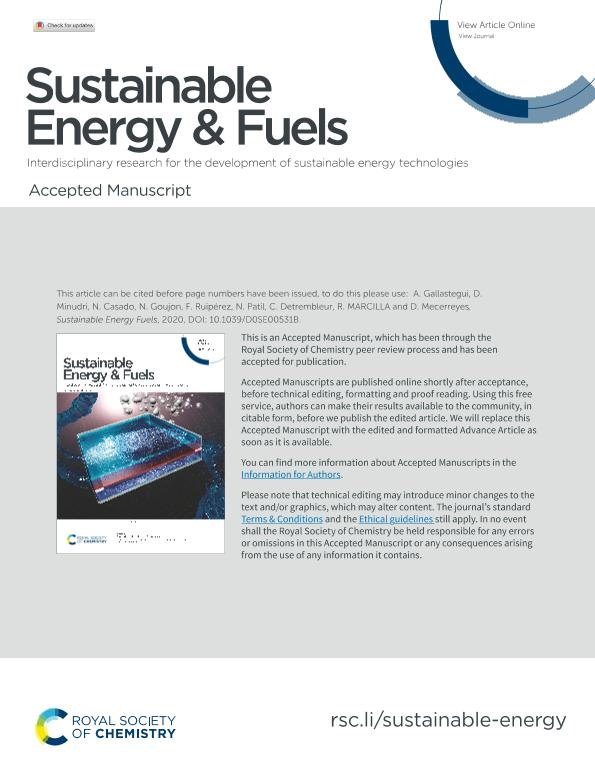Artículo
Proton trap effect on catechol-pyridine redox polymer nanoparticles as organic electrodes for lithium batteries
Gallastegui, Antonela ; Minudri, Daniela
; Minudri, Daniela ; Casado, Nerea; Goujon, Nicolas; Ruipérez, Fernando; Patil, Nagaraj; Detrembleur, Christophe; Marcilla, Rebeca; Mecerreyes, David
; Casado, Nerea; Goujon, Nicolas; Ruipérez, Fernando; Patil, Nagaraj; Detrembleur, Christophe; Marcilla, Rebeca; Mecerreyes, David
 ; Minudri, Daniela
; Minudri, Daniela ; Casado, Nerea; Goujon, Nicolas; Ruipérez, Fernando; Patil, Nagaraj; Detrembleur, Christophe; Marcilla, Rebeca; Mecerreyes, David
; Casado, Nerea; Goujon, Nicolas; Ruipérez, Fernando; Patil, Nagaraj; Detrembleur, Christophe; Marcilla, Rebeca; Mecerreyes, David
Fecha de publicación:
02/08/2020
Editorial:
Royal Society of Chemistry
Revista:
Sustainable Energy and Fuels
ISSN:
2398-4902
Idioma:
Inglés
Tipo de recurso:
Artículo publicado
Clasificación temática:
Resumen
Organic redox-active materials are actively being searched as a more sustainable alternative to traditional inorganic cathodes used in rechargeable batteries. Among the different types of organic cathodes, redox polymers based on catechol groups show high energy storage capacities. In this article, we show how the introduction of pyridine groups can shift the potential of catechol containing polymers towards more positive values further enhancing their energy storage capacities. For this purpose, we carried out the synthesis of redox-active polymer nanoparticles having catechol and pyridine functionalities. Spherical nanoparticles between 150 and 300 nm were synthesized by a surfactant-free emulsion polymerization method by copolymerization of dopamine methacrylamide and 4-vinyl pyridine. The chemical composition of the nanoparticles was confirmed by FTIR spectroscopy which shows the presence of catechol-pyridine hydrogen bonding. Thermal analyses (DSC, TGA) confirmed the glass transition of the nanoparticles between 158 and 190 °C and high thermal stability with a degradation temperature of 300 °C at 5% weight loss (Td5%). The electrochemical characterization of the redox-active polymer nanoparticles show that the redox potential of the catechol group was not affected by the presence of the pyridine in acidic electrolytes (E1/2 = 0.45 V versus Ag/AgCl). However, in organic electrolytes containing a lithium salt the redox potential of the catechol nanoparticles shifted from 0.27 V for catechol homopolymer, to 0.56 V for the catechol-pyridine copolymer. This positive potential gain could be associated to the proton trap effect as indicated by DFT calculations. Finally, the beneficial effect of the proton trap effect onto the performance of lithium-ion-polymer battery was demonstrated. The lithium vs. polymer cells showed a promising practical high voltage organic cathode (3.45 V vs. Li+/Li), excellent rate performance (up to 120C) and high capacity retention after cycling (74% after 800 cycles).
Palabras clave:
Proton trap
,
Redox active
,
Lithium batteries
,
Catechol
Archivos asociados
Licencia
Identificadores
Colecciones
Articulos (IITEMA)
Articulos de INSTITUTO DE INVESTIGACIONES EN TECNOLOGIAS ENERGETICAS Y MATERIALES AVANZADOS
Articulos de INSTITUTO DE INVESTIGACIONES EN TECNOLOGIAS ENERGETICAS Y MATERIALES AVANZADOS
Articulos(CCT - CORDOBA)
Articulos de CTRO.CIENTIFICO TECNOL.CONICET - CORDOBA
Articulos de CTRO.CIENTIFICO TECNOL.CONICET - CORDOBA
Citación
Gallastegui, Antonela; Minudri, Daniela; Casado, Nerea; Goujon, Nicolas; Ruipérez, Fernando; et al.; Proton trap effect on catechol-pyridine redox polymer nanoparticles as organic electrodes for lithium batteries; Royal Society of Chemistry; Sustainable Energy and Fuels; 4; 8; 2-8-2020; 3934-3942
Compartir
Altmétricas



